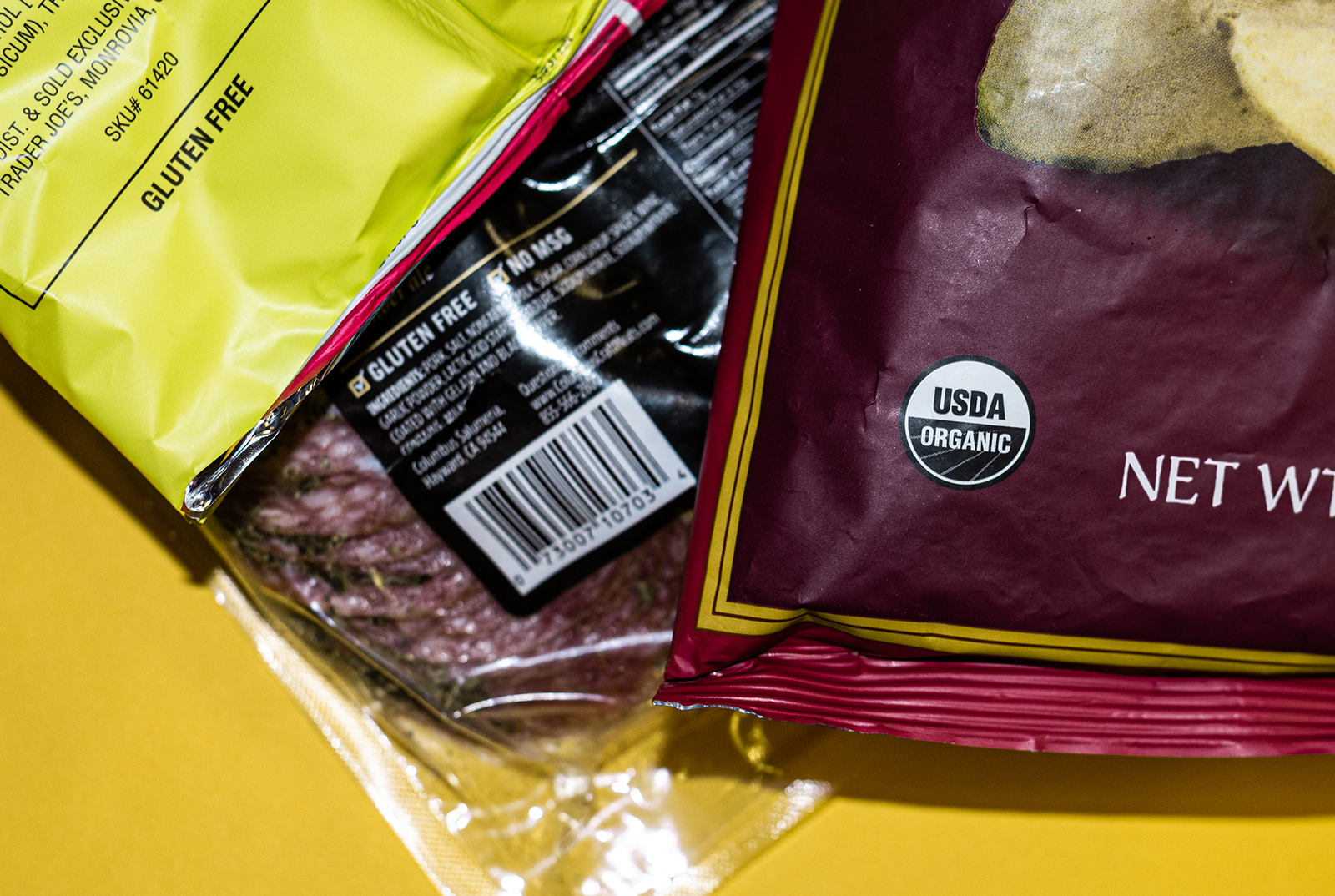The Quad: Going beyond organic labels on groceries – what U.S. food regulations really mean

Many food products found in grocery stores have labels like “all natural,” “organic” or “low-fat,” but these descriptions can be misleading and don’t always mean the product is healthy. (Liz Ketcham/Photo editor)

By Jenna Hajny
Feb. 17, 2020 11:07 p.m.
This post was updated Feb. 18 at 2:50 p.m.
Today’s grocery stores stock packaged foods with a wide variety of labels, like “100% natural,” “multigrain” and “heart-healthy.” Are these labels truthful or just another marketing scheme?
Incorporating health buzzwords has become a key marketing tactic for food production companies. The International Food Information Council Foundation’s 2018 Food & Health Survey discovered that nearly 40% of consumers were more likely to buy a product labeled as “natural” when shopping. Additionally, over 80% of consumers associated the labels “Vitamin D,” “fiber” and “whole grains” with a healthy product.
While these qualities may sound enticing, a lack of regulation around health marketing can misconstrue a product’s quality and health benefits. But don’t fear – The Quad has a guide to navigating common food buzzwords so you can distinguish health-food impostors from the real deal.
“Organic” is one of the most well-known health food labels, so much so that organic foods often even have their own section in the produce aisle. When observing an organic label, it’s important to remember without a United States Department of Agriculture seal, the food is not actually certified organic by the U.S. government. Organic guidelines also vary based on the particular product.
Produce is considered organic by the USDA if it’s been grown in soil free of prohibited substances, such as synthetic fertilizers and pesticides, for three years before it’s harvested. For meat to be organic, the animals must be fed organic crops and raised without antibiotics or hormones. When it comes to processed foods, the USDA prohibits artificial preservatives, colors and flavors.
While organic products have less pesticide residue, an organic label is an indication of the farming practices used, not a product’s health. Processed organic foods can still be high in ingredients linked to heart disease and diabetes such as saturated fat and sugar. Therefore, organic cookies and chips are not necessarily healthier than their nonorganic counterparts.
However, in recent years consumer’s trust in the USDA organic label has been challenged. An activist group filed a complaint against Aurora Organic Dairy in 2017 that challenged the company’s organic standards. However, the USDA found no violations of organic standards by Aurora Organic Dairy, finding that the company did comply with USDA regulations.
Incidents like these have uncovered major inspection issues in certifying USDA organic products. Fortunately, there are complementary labels to look out for that help increase a product’s credibility. Examples include “Certified Naturally Grown” and “Animal Welfare Approved.”
Another important label in assessing a food’s quality is non-GMO. While genetically modified organisms are prohibited in certified organic foods, not all non-GMO products are organic. Foods free of GMOs can still be grown with chemical pesticides. Similar to organic products, a non-GMO label is not an indicator of a food’s nutritional value.
In general, GMOs involve significantly more controversy than other food labels. According to The New York Times, 90% of scientists believe GMOs are safe for human consumption – however, only about 33% of consumers agree with this sentiment.
In terms of misleading marketing, “all natural” likely takes first prize. “All natural” is not interchangeable with “organic” and “non-GMO.”
While both of the latter must meet specific USDA guidelines, all natural doesn’t have to meet any specific set of guidelines. In fact, the Food and Drug Administration currently has no formal definition of what it means to be an “all natural” product, making it essentially a meaningless term on packaged foods.
While the FDA doesn’t regulate the use of the term “natural,” a product that meets this qualification would be free of artificial ingredients or added colors. It would also be minimally processed.
Today, if you see “natural” on a cereal box or package of fruit snacks, it does not mean that these products are free of harmful artificial preservatives, colors or flavors. Intuitively, it does not make sense for a candy bar to be all natural since it’s not a whole food like carrots and apples.
When cruising through the grocery store, you’ll also likely come across the label “gluten-free.” For a product to be gluten-free, it cannot contain wheat, spelt, rye or barley. When searching for an evening treat, a gluten-free option is not inherently healthier than the regular version.
In fact, many gluten-free foods actually contain more unhealthy fats and sugar to compensate for the structural and textual deficits of gluten-free flours. A study conducted by the Pan American Health Organization surveying 66 gluten-free alternatives uncovered that 80% had higher sugar levels.
When looking for dairy and desserts, low-fat and low-calorie options are very popular marketing schemes. According to the FDA, low-calorie foods have to have one-third fewer calories than the brand’s original product, if the original has 50% or more calories from fat.
The same principle applies to low-fat products. While this sounds great, it typically decreases a product’s nutritional value. In the case of low-fat yogurt, for example, the decreased fat content is replaced with added sugars. The USDA recommends adults consume no more than 50 grams of sugar daily. Yet, some low-fat yogurts contain almost 30 grams of sugar – that’s more than half your daily serving.
When buying processed foods like bread or breakfast cereal, it’s important to actually read the nutrition facts rather than falling for empty promises on the front of the package.
Fat-free cookies may sound like the holy grail, but unfortunately, they’re too good to be true. Rather than trying to eliminate consumption of such ingredients, being more mindful about what health labels means will help you stay conscious of what you’re really putting into your body.

